
The pipe organ is a musical instrument that produces sound by driving pressurized air through the organ pipes selected from a keyboard. Because each pipe produces a single pitch, the pipes are provided in sets called ranks, each of which has a common timbre and volume throughout the keyboard compass. Most organs have many ranks of pipes of differing timbre, pitch, and volume that the player can employ singly or in combination through the use of controls called stops.
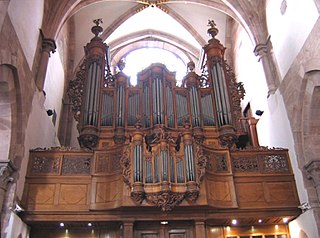
In music, the organ is a keyboard instrument of one or more pipe divisions or other means for producing tones, each played with its own keyboard, played either with the hands on a keyboard or with the feet using pedals.

Rodgers Instruments Corporation is an American manufacturer of classical and church organs. Rodgers was incorporated May 1, 1958 in Beaverton, Oregon by founders, Rodgers W. Jenkins and Fred Tinker, employees of Tektronix, Inc., of Portland, Oregon, and members of a Tektronix team developing transistor-based oscillator circuits. Rodgers was the second manufacturer of solid state oscillator-based organs, completing their first instrument in 1958. Other Rodgers innovations in the electronic organ industry include solid-state organ amplifiers (1962), single-contact diode keying (1961), reed switch pedal keying for pedalboards (1961), programmable computer memory pistons (1966), and the first MIDI-supported church organs (1986).
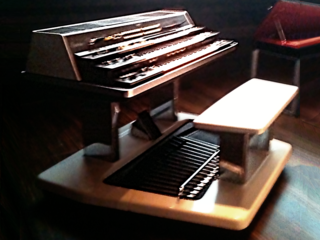
An electric organ, also known as electronic organ, is an electronic keyboard instrument which was derived from the harmonium, pipe organ and theatre organ. Originally designed to imitate their sound, or orchestral sounds, it has since developed into several types of instruments:

A pedalboard is a keyboard played with the feet that is usually used to produce the low-pitched bass line of a piece of music. A pedalboard has long, narrow lever-style keys laid out in the same semitone scalar pattern as a manual keyboard, with longer keys for C, D, E, F, G, A and B, and shorter, raised keys for C♯, D♯, F♯, G♯ and A♯. Training in pedal technique is part of standard organ pedagogy in church music and art music.

A theatre organ is a distinct type of pipe organ originally developed to provide music and sound effects to accompany silent films during the first 3 decades of the 20th century.
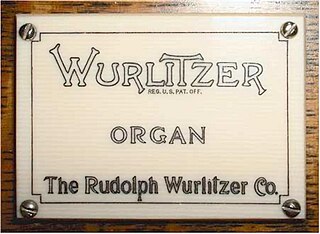
The Rudolph Wurlitzer Company, usually referred to as simply Wurlitzer, is an American company started in Cincinnati in 1853 by German immigrant (Franz) Rudolph Wurlitzer. The company initially imported stringed, woodwind and brass instruments from Germany for resale in the United States. Wurlitzer enjoyed initial success, largely due to defense contracts to provide musical instruments to the U.S. military. In 1880, the company began manufacturing pianos and eventually relocated to North Tonawanda, New York. It quickly expanded to make band organs, orchestrions, player pianos and pipe or theatre organs popular in theatres during the days of silent movies.

Casavant Frères is a Canadian organ building company in Saint-Hyacinthe, Quebec, which has been building pipe organs since 1879. As of 2014, the company has produced more than 3,900 organs.

Ernest Martin Skinner was one of the most successful American pipe organ builders of the early 20th century. His electro-pneumatic switching systems advanced the technology of organ building in the first part of the 20th century.

A manual is a musical keyboard designed to be played with the hands, on an instrument such as a pipe organ, harpsichord, clavichord, electronic organ, melodica, or synthesizer. The term "manual" is used with regard to any hand keyboard on these instruments to distinguish it from the pedalboard, which is a keyboard that the organist plays with their feet. It is proper to use "manual" rather than "keyboard", then, when referring to the hand keyboards on any instrument that has a pedalboard.
Mathias Peter Møller, commonly known as M.P. Möller or Moeller, was a prolific pipe-organ builder and businessman. A native of the Danish island of Bornholm, he emigrated to the United States in 1872 and founded the M.P. Moller Pipe Organ Company in Greencastle, Pennsylvania, in 1875. The city of Hagerstown, Maryland, took notice of Möller's early successes and induced him to move his business there in 1881 to help make it a viable business center in Western Maryland. The company remained in business until 1992, with hundreds of employees at its peak and a lifetime production of over 12,000 instruments.

Austin Organs, Inc., is a manufacturer of pipe organs based in Hartford, Connecticut. The company is one of the oldest continuously-operating organ manufacturers in the United States. The first instruments were built in 1893 with the Austin Patent Airchest, and many remain in fine playing condition to this day.
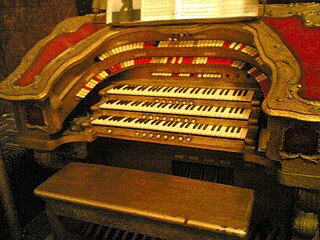
The Bartola Musical Instrument Company of Oshkosh, Wisconsin, USA, was a producer of theater pipe organs during the age of silent movies.

Built by the Shriners architects Huehl and Schmidt in 1912, the Medinah Temple is a colorful Islamic-looking building replete with pointed domes and an example of Moorish Revival architecture. It is located on the Near North Side of Chicago, Illinois at 600 N. Wabash Avenue, extending from Ohio Street to Ontario Street.

The Robert Morton Organ Company was a producer of theater pipe organs and church organs, located in Van Nuys, California. Robert Morton was the number two volume producer of theatre organs, building approximately half as many organs as the industry leader Wurlitzer. The name Robert Morton was derived not from any person in the company, but rather from the name of company president Harold J. Werner's son, Robert Morton Werner.

The Church of St. Paul the Apostle is a Catholic church on the Upper West Side of Manhattan in New York City. It is the mother church of the Paulist Fathers, the first order of Catholic priests founded in the United States
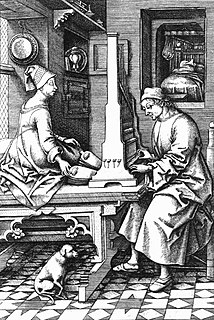
A residence organ is a musical organ installed in a personal home. Strictly speaking, the names residence and house organ are the most correct, the others being types of organs that can physically be used as residence organs, but that are not restricted to use solely in that context, and can also be used in, say, small churches, theatres, and so forth. A portative organ or a positive organ can be used in a residential setting, but the notion of a residence organ strictly embodies a permanence of place that is belied by the notion of portability embodied by the portatives and positives. Similarly, a chamber organ is in general a small organ for a room, but not necessarily for a room of someone's home.
The Marr & Colton Company was a producer of theater pipe organs, located in Warsaw, New York. The firm was founded by David Jackson Marr and John J. Colton. The company built between 500 and 600 organs for theatres, churches, auditoriums, radio stations, and homes.
The Organ Grinder Restaurant was a Portland, Oregon pizzeria in operation from 1973 to 1996. At one point it housed the largest theater pipe organ of its type in the world.















